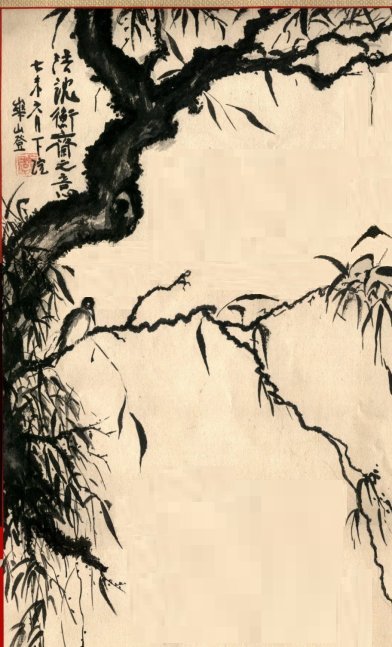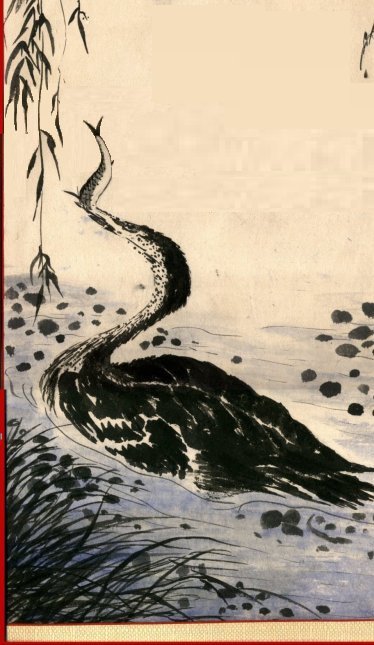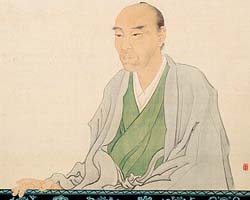



Duck Catching Fish Ink Painting by 19C Japanese Master Painter Watanabe Kazan (1793-1841)
日本明治時代南畫流大畫家渡邊華山(1793-1841)鴨捕魚水墨畫
Kazan 崋山(1793-1841) N. Watanabe Sadayasu 渡邊定靜 A. Shian 子安, Hakuto伯登 F.N. Nobori 登 Go. Kazan 華山, 崋山, Gukaido 寓繪堂, Zenrakudo 全樂堂, Sakuhi-koji 昨非居士, Kintonkyo 金暾居, Zuian koji 隨安居士. S. Nanga school. Distinquished painter of the Edo period. Pupil of Buncho. His pupil: Chinzan, Hanko, etc. Taking the good poimnts of Nanga and Western styles, developed his own one. L&C. Born in Edo. Several lord Miyake, a samurai of the clan of Tawara. In 1179, falsely charged by Tawara government, he was confined to his home in Tawara and committed suicide there in 1841. Sp. flowers-and-birds, portraits.主要影響 N. 74. Kazan-sensei-gafu 崋山先生畫譜, Watanable Kazan 渡邊崋山, Watanable Ibokujo 渡邊崋山遺墨帖
Watanabe Kazan
(b Edo [now Tokyo], 1793; d Tawara [now in Aichi Prefect.], 1841). Japanese painter. He was the son of an impoverished retainer of the Miyake family, holders of the small Tawara fief. He began to study painting in his teens, having been advised that he could finance his Confucian studies through art. Kazan’s first teacher was a little-known painter, Shirakawa Shizan (1765-1857). When Shizan dismissed him for non-payment of tuition fees, Kazan took up his studies with Kaneko Kinryo (d 1817), a pupil of TANI BUNCHO who produced bird-and-flower and animal paintings. Perhaps with an introduction from Kinryo, Kazan himself began to study under Buncho in 1809. His talent was immediately recognized, and within a few years Kazan had pupils of his own and was adding greatly to his family's meagre stipend with profits from painting sales. In 1819 he hosted his first shogakai, a creative gathering of poets, calligraphers and painters.
WATANABE KAZAN (1793-1841). Edo period
Kazan was a man of samurai class who studied both European and Nanga styles of painting. He introduced Western techniques into his paintings. The painting carries the signature and seal of the artist and an inscription in which he said that the painting is to follow the style of 18C Chinese Nanga Master Shen Heng.
Kazan, a progressive and patriotic man, dared to criticize the national isolation policy of the Tokugawa Shogunate and for this was confined to his native town, where he later took his own life.
 Kazan Watanabe was active as a scholar, a
painter and a politician. He was born at the Edo (Tokyo)
Kamiyashiki residence of the Tahara clan. From the age of eight,
he served the clan, while studying the teaching of Chutzu and
Wang Yang-ming with Seiko Takami, Issai Sato, and Kodo Matsuzaki.
He painted from childhood. He was found to be good at drawing,
and he drew pictures with unique lines. He adopted perspective
representation from Western paintings, and he produced many
well-known paintings. He was promoted to the position of
councilor at the age of 40. He conteibuted to the prosperity of
the Tahara Clan. He is well known for not letting a single person
die or become homeless during the Tenpo mass starvation period by
creating a "Houminsou," a warehouse. He continued to
study western affairs with Choei Takano and others, and he
published the "Shinkiron," which suggested abolishing
the national isolation policy. But the book was considered to be
a criticism of the Shogunate, and he was confined to his
residence in Tahara. Afraid that he might bring disaster to the
Clan, he committed suicide at the age of 49.
Kazan Watanabe was active as a scholar, a
painter and a politician. He was born at the Edo (Tokyo)
Kamiyashiki residence of the Tahara clan. From the age of eight,
he served the clan, while studying the teaching of Chutzu and
Wang Yang-ming with Seiko Takami, Issai Sato, and Kodo Matsuzaki.
He painted from childhood. He was found to be good at drawing,
and he drew pictures with unique lines. He adopted perspective
representation from Western paintings, and he produced many
well-known paintings. He was promoted to the position of
councilor at the age of 40. He conteibuted to the prosperity of
the Tahara Clan. He is well known for not letting a single person
die or become homeless during the Tenpo mass starvation period by
creating a "Houminsou," a warehouse. He continued to
study western affairs with Choei Takano and others, and he
published the "Shinkiron," which suggested abolishing
the national isolation policy. But the book was considered to be
a criticism of the Shogunate, and he was confined to his
residence in Tahara. Afraid that he might bring disaster to the
Clan, he committed suicide at the age of 49.
渡邊華山(1793-1841)
原名叫定靜,又有人通常稱他為登,除了華山之外還有金樂堂、寓繒堂等雅號。他是生於三河(愛知縣)田原藩士之家,從小生活貧困,日子過得很苦,他是為了幫助家庭經濟而學畫。拜在谷文晁的門下,也受了沈南蘋的影響,更會了西洋畫的陰影立體感的肖像畫,這是他最得意的地方。後來也曾擔任過藩主的家老要職,由於極為關心蘭學(即西方的知識),思想很進步,曾與高野長英等人共同研究海外時事與海岸防備等學問,遭政府彈壓,於「蠻社之獄」被捕,在田原藩被命令自殺身亡。他的代表作有[鷹見泉石像](東京國立博物館藏)和[市河米庵像]、[一掃百態圖]等。也有關於西洋學的書論出版.
Click Here to See Other Japanese Paintings